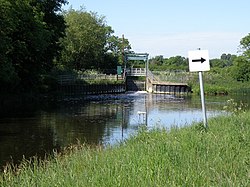Alwalton: Difference between revisions
mNo edit summary |
No edit summary |
||
| Line 12: | Line 12: | ||
|LG district=Huntingdonshire | |LG district=Huntingdonshire | ||
}} | }} | ||
'''Alwalton''' is a village in northern [[Huntingdonshire]], five miles to the west of the city of [[Peterborough]], quarter of a mile from the Great North Road | '''Alwalton''' is a village in northern [[Huntingdonshire]], five miles to the west of the city of [[Peterborough]], a quarter of a mile from the Great North Road. | ||
The village lies north west of [[Yaxley, Huntingdonshire|Yaxley]], overlooking the southern bank of the [[River Nene]] and close to the line of [[Ermine Street]] or the A1 road. Alwalton is a conservation area with a number of listed buildings, the most important of which are the Norman Church of St Andrew's and the Elizabethan manor House. | The village lies north west of [[Yaxley, Huntingdonshire|Yaxley]], overlooking the southern bank of the [[River Nene]] and close to the line of [[Ermine Street]] or the A1 road. Alwalton is a conservation area with a number of listed buildings, the most important of which are the Norman Church of St Andrew's and the Elizabethan manor House. | ||
The village is an old one, and there is evidence that there was some kind of building here during Roman times as some coins and pieces of pottery have been found. The Roman town of ''Durobrivae'' lay half a mile to the | The village is an old one, and there is evidence that there was some kind of building here during Roman times as some coins and pieces of pottery have been found. The Roman town of ''Durobrivae'' lay half a mile to the north-west, on the Roman Road. | ||
A petrifying spring rises in the village. A stone known as "Alwalton marble" is found on the banks of the River Nene hereabouts. | A petrifying spring rises in the village. A stone known as "Alwalton marble" is found on the banks of the River Nene hereabouts. | ||
| Line 22: | Line 22: | ||
The East of England Showground lies to the south of the village. The 240-acre site is used each June for the East of England Show and at other times for commercial exhibitions. | The East of England Showground lies to the south of the village. The 240-acre site is used each June for the East of England Show and at other times for commercial exhibitions. | ||
Sir Henry Royce (27 March 1863 – 22 April 1933), co founder of Rolls-Royce, was born in the village and his ashes | Sir Henry Royce (27 March 1863 – 22 April 1933), co-founder of Rolls-Royce, was born in the village and his ashes are buried in St Andrew's Church where a plaque can be seen on the wall as well on a spot on the floor where beneath his ashes were buried in an urn. His urn was originally buried in 1933 beneath a statue of him at the Rolls-Royce works in [[Derby]] but in 1937 his urn was removed from there and was brought to Alwalton. | ||
==Outside links== | ==Outside links== | ||
{{Commons category|Alwalton}} | {{Commons category|Alwalton}} | ||
Latest revision as of 08:57, 5 December 2019
| Alwalton | |
| Huntingdonshire | |
|---|---|
 Alwalton weir on the Nene | |
| Location | |
| Grid reference: | TL141960 |
| Location: | 52°33’-0"N, 0°19’12"W |
| Data | |
| Post town: | Peterborough |
| Postcode: | PE7 |
| Local Government | |
| Council: | Huntingdonshire |
Alwalton is a village in northern Huntingdonshire, five miles to the west of the city of Peterborough, a quarter of a mile from the Great North Road.
The village lies north west of Yaxley, overlooking the southern bank of the River Nene and close to the line of Ermine Street or the A1 road. Alwalton is a conservation area with a number of listed buildings, the most important of which are the Norman Church of St Andrew's and the Elizabethan manor House.
The village is an old one, and there is evidence that there was some kind of building here during Roman times as some coins and pieces of pottery have been found. The Roman town of Durobrivae lay half a mile to the north-west, on the Roman Road.
A petrifying spring rises in the village. A stone known as "Alwalton marble" is found on the banks of the River Nene hereabouts.
The East of England Showground lies to the south of the village. The 240-acre site is used each June for the East of England Show and at other times for commercial exhibitions.
Sir Henry Royce (27 March 1863 – 22 April 1933), co-founder of Rolls-Royce, was born in the village and his ashes are buried in St Andrew's Church where a plaque can be seen on the wall as well on a spot on the floor where beneath his ashes were buried in an urn. His urn was originally buried in 1933 beneath a statue of him at the Rolls-Royce works in Derby but in 1937 his urn was removed from there and was brought to Alwalton.
Outside links
| ("Wikimedia Commons" has material about Alwalton) |
